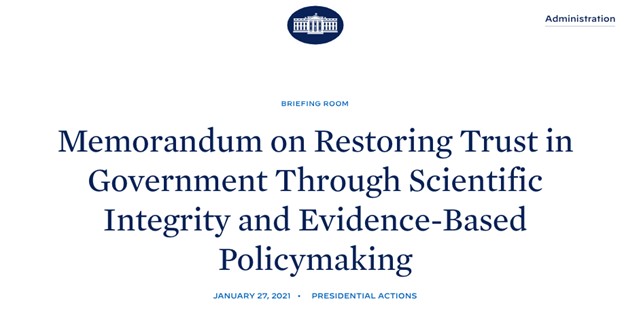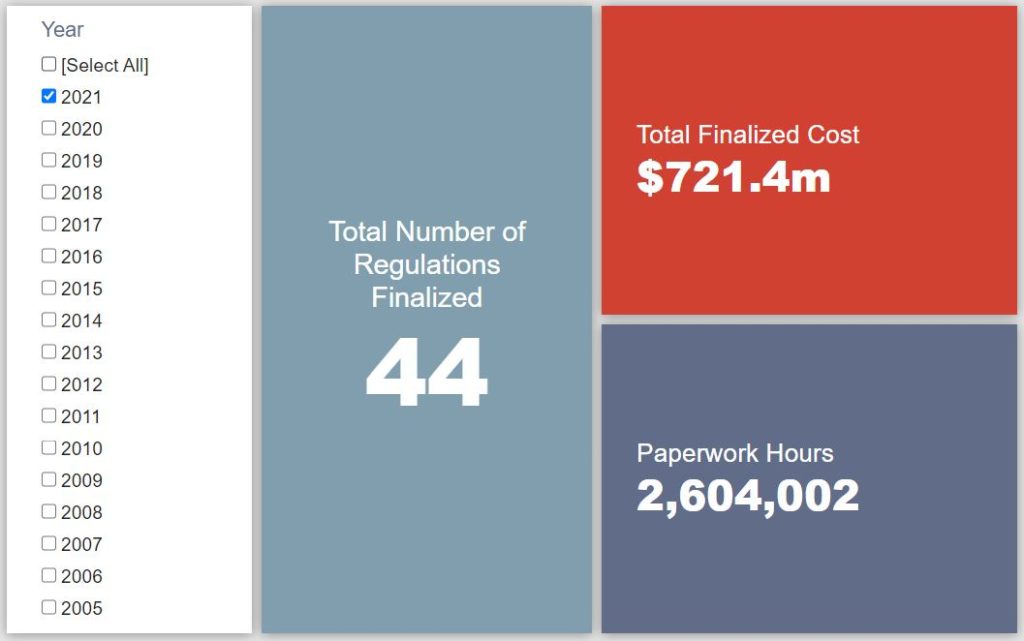Week in Regulation
February 16, 2021
Regulatory Activity Remains Chilled
While it is unclear whether it is Punxsutawney Phil’s fault, regulatory winter continues. Only one rulemaking with any measurable economic impact was published last week. There was little else of note aside from the Biden Administration establishing its protocol for addressing scientific transparency. With just that single rulemaking, agencies published $266 million in total net costs but cut 270 hours of annual paperwork.
REGULATORY TOPLINES
- Proposed Rules: 34
- Final Rules: 58
- 2021 Total Pages: 9,420
- 2021 Final Rule Costs: $721.4 million
- 2021 Proposed Rule Costs: -$8.1 billion
NOTABLE REGULATORY ACTIONS
Seeing how it was the only rule to record, by default, the most significant rulemaking of the week was a joint rule by a group of financial regulators regarding “Net Stable Funding Ratio: Liquidity Risk Measurement Standards and Disclosure Requirements.” This rule:
Establishes a quantitative metric, the NSFR [net stable funding ratio], to measure the stability of the funding profile of certain large banking organizations and requires these banking organizations to maintain minimum amounts of stable funding to support their assets, commitments, and derivatives exposures over a one-year time horizon.
The Office of the Comptroller of the Currency estimates – as required by the Unfunded Mandates Reform Act – that the rule will impose $266 million in costs upon affected institutions.
TRACKING THE ADMINISTRATIONS
As we have already seen from executive orders and memos, the Biden Administration will surely provide plenty of contrasts with the Trump Administration on the regulatory front. And while there is a general expectation that the new administration will seek to broadly restore Obama-esque regulatory actions, there will also be areas where it charts its own course. Since the American Action Forum’s RegRodeo data extend back to 2005, it is possible to provide weekly updates on how the top-level trends of President Biden’s regulatory record track with those of his two most recent predecessors. The following table provides the cumulative totals of final rules containing some quantified economic impact from each administration through this point in their respective terms.
![]()
The NSFR rule is far and away the most consequential rule (in terms of economic impact, at least) published thus far in Biden’s tenure, pushing the administration’s cumulative cost total into the hundreds of millions of dollars. Nevertheless, that total still lags far behind that of the two prior administrations through a similar point. There are limited conclusions to draw from this week’s shifts in terms of broader historical trends though.
THIS WEEK’S REGULATORY PICTURE
By Thomas O’Rourke, Regulatory Policy Intern
This week, the Biden Administration publishes a memorandum outlining its use of science.

On February 10, the Federal Register published the “Memorandum on Restoring Trust in Government Through Scientific Integrity and Evidence-Based Policymaking,” in which President Biden detailed how agencies will treat scientific information in their rulemaking processes.
Among the most significant actions taken in the memo is the establishment of the “Task Force on Scientific Integrity,” an interagency council likely soon to be led by Eric Lander, President Biden’s nominee for the Director of Science and Technology Policy. The Task Force’s primary responsibility will be reviewing scientific-integrity policies across agencies to ensure that there is no “improper political interference in the conduct of scientific research and the collection of scientific or technological data.”
The memo also sets forth transparency goals for agencies, requiring the Task Force to review each agencies’ reporting practices on their scientific integrity policies. At the conclusion of this review, the Task Force is called upon to synthesize its findings, recommending best practices for agencies moving forward.
Efforts to promote the use of science in the rulemaking process come in response to claims that the Trump Administration sought to limit science’s role in forming policy. Just last week a federal court struck down a Trump-era Environmental Protection Agency (EPA) rule entitled “Strengthening Transparency in Pivotal Science Underlying Significant Regulatory Actions and Influential Scientific Information,” which some argued limited the types of research that the EPA could use in creating policy. The court ruling was on the basis of how the rule was structured, however, and its substance was not addressed.
The memo also details a proactive role for the Office of Management and Budget, calling upon it to “issue guidance to improve agencies’ evidence-building plans and annual evaluation plans.”
Agency heads will also be held accountable for ensuring that proposed rules are based on the best available evidence. Specifically, the memo calls for expanding access to federal data for “governmental and non-governmental researchers” to ensure that subject matter experts can review and comment on both the efficacy of proposed rules and accuracy of underlying data. While many in the scientific community applaud these efforts, there is growing skepticism that agencies will actually be held accountable for implementing integrity policies.
President Biden’s plan to promote scientific integrity and increase transparency will certainly face administrative roadblocks but will likely shape the use of science in the federal rulemaking process for the duration of his administration.
TOTAL BURDENS
Since January 1, the federal government has published $7.4 billion in total net cost savings (with $721.4 million from finalized rules) and 8.9 million hours of net annual paperwork burden reductions (with 2.6 million hours in increases from final rules).












